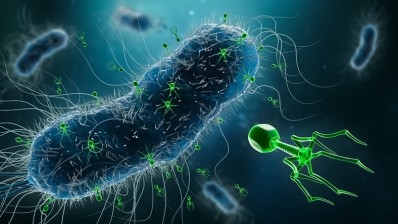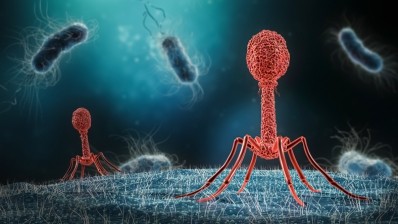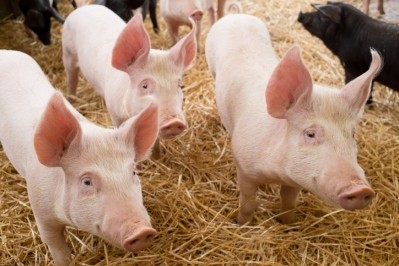Pros and cons of phage therapy, probiotics and postbiotics as strategies to control post-weaning diarrhea in pigs
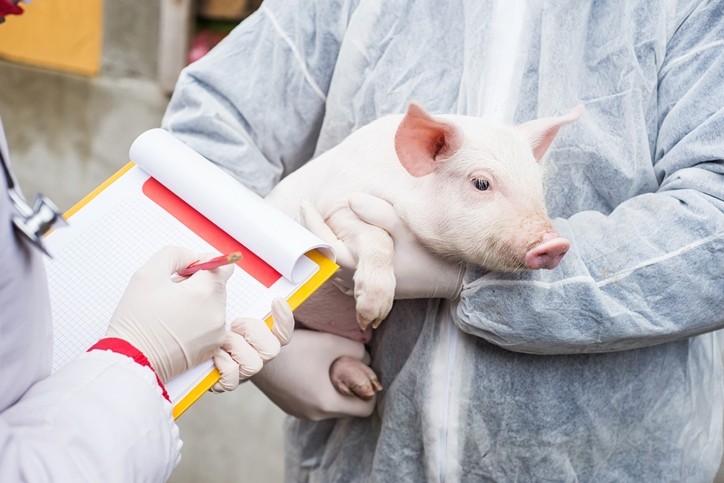
“Further investigation into these additives is required, and upon a deeper understanding of the mechanisms at play, this strategy may potentially lead to a reduction of pathogen adhesion and aid in pathogen control upon colonization,” according to the animal scientists participating in this review, which was published in Veterinary Microbiology.
The reviewers, among them, Dr John Pluske, from the faculty of Veterinary and Agricultural Sciences at the University of Melbourne, also determined that more studies are needed to optimize the use of organic acids in weaner diets, while rations containing low levels of crude protein (CP) can have benefits in terms of reduced diarrhea but it is not always clear cut.
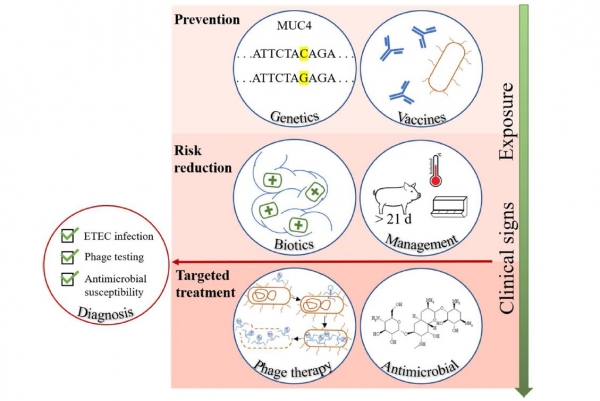
Resistance
Strains of enterotoxigenic Escherichia coli (ETEC) causing post-weaning diarrhea (PWD) in piglets have a widespread and detrimental impact on animal health and the economics of pork production, wrote the Australian team.
Traditional approaches to control and prevention of E. coli triggered diarrhea have placed a strong emphasis on antimicrobial use (AMU) to the extent that current prevalent porcine ETEC strains have developed moderate to severe resistance, said the animal scientists.
“This complicates treatment of ETEC infection by limiting therapeutic options, increasing diagnostic costs and increasing mortality rates.
“Management factors, the use of supra-physiological levels of zinc oxide and selected feed additives have all been documented to lower the incidence of ETEC infection in pigs; however, each intervention has its own limitations and cannot solely be relied upon as an alternative to AMU.
“Consequently, treatment options for porcine ETEC are moving towards the use of newer antimicrobials of higher public health significance.”
Vaccines
The last decade of research, they remarked, has greatly progressed vaccination against ETEC infection in weaners, delivering methods that are beginning to overcome the narrow spectrum and administration issues of vaccination against ETEC.
“However, until a multivalent vaccine or a vaccine utilizing sufficiently conserved toxoids is commercialized, other control methods for ETEC infection in swine need to be explored and implemented.”
Zinc oxide
Zinc oxide (ZnO), they said, is well-established as a feed additive, with multiple studies having demonstrated its positive effects when included at supra-physiological levels in the diet in alleviating ETEC-induced PWD, and having shown its potential as an agent that could be used in place of antimicrobials in feed.
Despite this, there are two major issues concerning the use of feed containing supra-physiological levels of ZnO, they commented.
“The first is the high quantity of unabsorbed zinc (Zn) that is excreted in faces, resulting in environmental soil contamination from piggery effluent (Ciesinski et al., 2018). The second issue preventing the long-term usage of ZnO is the finding that high doses of ZnO select for antimicrobial-resistant bacteria.”
Lower CP levels
Evaluating strategies based on CP content, the team said it is known that rations high in CP result in a greater proportion of protein remaining undigested in the small intestine, with this undigested protein, as well as excess endogenous nitrogen, passing through to the large intestine.
“The unabsorbed protein is fermented in the large intestine by nitrogen utilizing bacterial species, including E. coli, encouraging the growth of this potentially pathogenic species.
“The fermentation process results in increased levels of toxic end products that damage the gut mucosa, with these compounds also being implicated in the etiology of PWD (Heo et al., 2015; Wang et al., 2018),” said Pluske and his colleagues.
Furthermore, they said that the decreased pH levels associated with high protein diets favor the proliferation of many pathogenic bacterial species in the large intestine (Wang et al., 2018), including ETEC.
“As a result, a reduction of dietary CP has been proposed as a method to reduce PWD in swine by limiting fermentation of protein in the distal GIT, and therefore, reducing proliferation of bacterial species and levels of detrimental compounds. This has been demonstrated numerous times in pigs fed lower protein diets supplemented with essential amino acids, with a measurable decrease in protein fermentation and reduction in the incidence of PWD (Heo et al., 2015; Wang et al., 2018).”
They citied research - a study by Heo et al. (2015) including the analysis of four datasets from experiments comparing low and high protein weaners diets – that demonstrated a positive linear relationship between daily dietary protein intake and incidence of PWD in diets containing more than 60 g of daily protein per pig.
“Nevertheless, some studies have shown inferior performance with feeding lower protein diets after weaning,” noted the Australian review team, adding that is most likely attributable to an imbalance in the ideal protein ratio associated with types and concentrations of amino acids (Heo et al., 2013; Wang et al., 2018).
Organic acids
The addition of various organic acids to feed has been studied for their effects on reducing symptoms caused by ETEC infection in weaner pigs, said the team.
Organic acids reduce stomach pH values, subsequently increasing feed digestion, inhibiting the growth of pathogenic bacteria and favoring the growth of many beneficial bacteria (Ren et al., 2019; Tugnoli et al., 2020), they reported.
The acidic conditions also boost the physiological functions of the GI tract, activating pepsin, chelating minerals and enhancing secretion of enzymes (Tugnoli et al., 2020), they said.
Ren et al. (2019) studied the impact of organic acids in pigs challenged with ETEC. Formic and propionic acid added to the feed led to a reduced fecal consistency score (FCS) and rectal temperature compared to control pigs at 9 and 24-hours post-challenge.
“Despite this difference, the fecal pH values, fecal total coliform counts and fecal Lactobacillus counts were not significantly different between the groups at 24 and 48 hours post challenge (Ren et al., 2019).
“However, this may be due to these data representing the effect on feces, with the effect in the small intestine being unmeasured.”
They called for further studies identifying the effects of organic acids against ETEC infection in all sections of the GI tract to optimize organic acid parameters in weaners diets.
Their review assessed a range of alternative treatment options then with a particular focus on microorganisms. “Studies based around bacteriophage therapy, probiotics and the use of probiotic fermentation products as postbiotics have demonstrated promise.”
Prebiotics
The team said substrates that have potential as prebiotics must selectively favor the growth of beneficial bacterial genera, such as Lactobacillus and Bifidobacterium. “This manipulation of the gut microbiota alters its composition and improves its functionality, subsequently heightening protection against enteric pathogens (Angelakis, 2017).”
A prebiotic effect was demonstrated in vitro with casein glycomacropeptide and mannan-oligosaccharides reducing ETEC adherence to porcine intestinal epithelial cells (Hermes et al., 2011), they noted.
“However, the underlying mechanisms of prebiotics remain poorly characterized and limited studies on ETEC-challenged weaners have been completed (Angelakis, 2017),” they commented.
Probiotics, postbiotics and synbiotics
Reviewing a range of studies, the team argues that the benefits of probiotics are species dependent (Luise et al., 2019a).
Whilst studies demonstrate the beneficial impact of probiotics on ETEC infections, the specific mechanism of action of many probiotic strains remains uncertain, they said.
“Recent studies have begun to shed light on the matter, including those of Tian et al. (2016) demonstrating E. faecium acts by inhibiting adhesion of ETEC to enterocytes and reducing the proinflammatory response induced by ETEC infection; however, more studies that increase our understanding of the action of probiotics are necessary to optimize probiotic use.”
Postbiotics, the fermentation products of probiotic strains, are often a poorly defined mixture of sugars, amino acids and proteins, but these are receiving increased attention as potential modulators of gut health and are being investigated for advantageous effects on the gut microbiota and overall host health, said the Australian scientists.
They reported that a beneficial health impact was detected in ETEC-challenged pigs receiving S. cerevisiae fermentation products (SFP), demonstrated as a greater bacterial diversity and a reduced prevalence of Enterobacteriaceae in the ileal digesta (Kiarie et al., 2011).
“Furthermore, a reduction in the number of ETEC adhering to the ileal mucosa and reduced levels of ammonia in the colon were also detected when compared to the control group. L. acidophilus fermentation products also led to a reduction in FCS in pigs receiving varying concentrations of the feed additive.”
In another study evaluated, they saw that a healthier microbiota was detected in pigs receiving postbiotics compared to control pigs, with an increased abundance of several beneficial bacteria in feces, including Lactobacillus spp. and Firmicutes. “However, no significant differences in weight gain were reported (Nordeste et al., 2017).”
Probiotics and prebiotics also have been studied for their synergistic potential, said the reviewers.
Wang et al. (2019) reported the effects of seven oligosaccharides on the probiotic L. plantarum ZLP001. Fructo-oligosaccharide (FOS) were demonstrated to improve the temperature stress tolerance and increase the growth performance of the probiotic. “When supplemented into weaner diets of healthy pigs, the synbiotic was shown to significantly increase ADG to 439 g, compared to the 398 g ADG of the control group.”
Despite the potential value of synbiotics, there are countless combinations of probiotics and prebiotics that need in vitro and in vivo testing, with their preventative impact on ETEC infection in weaners needing additional, rigorous assessment, they stressed.
“Furthermore, the financial aspects of these benefits in comparison to the increased costs associated with incorporation of multiple products in feed need to be evaluated to determine if it is financially viable.”
The main limitation in commercial use of probiotics, postbiotics and synbiotics is the uncertainty surrounding their effects due to the possibility of reporting bias, contradictory effects between studies and the difficulties surrounding ETEC challenge models, they added.
Phage therapy
Phage therapy has been reported to alleviate the severity of clinical symptoms induced by ETEC infection in swine, said the team.
However, the current literature presents a low level of knowledge of numerous phages instead of an in-depth knowledge of a few strong phage candidates, and phage therapy in swine remains novel, with the approval and regulation of phage-based products needing to be developed before products are commercially available, they cautioned.
In conclusion, the team said that the integration of a combination of alternative strategies offers the swine industry an approach to managing the production and financial burden of ETEC infection in the face of the One Health threat imposed by antimicrobial resistance (AMR).
“These strategies include current, alternative and novel approaches which collectively focus on preventing colonization of ETEC by reducing the risk of infection whilst providing targeted treatment for control of outbreaks. The continued development of broad-spectrum vaccines, as well as the identification and selection of genes effecting the host’s resistance to ETEC infection, may help control the specific ETEC fimbrial type present on farms. The global implementation of improved farm management, which encompasses heightened hygiene and biosecurity approaches such as through the all-in-all-out stocking approach and optimization of feeding regimens, can continue to reduce the rate of infection.”
Source: Veterinary Microbiology
DOI: https://doi.org/10.1016/j.vetmic.2021.109117
Title: Porcine enterotoxigenic Escherichia coli: Antimicrobial resistance and development of microbial-based alternative control strategies
Authors: TJ Laird, S Abraham, D Jordan, JR Pluske, DJ Hampson, DJ Trott, M O’Dea

